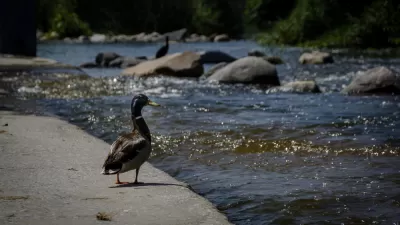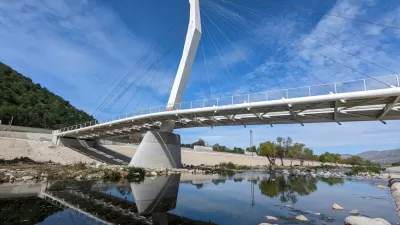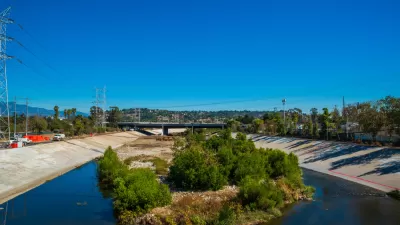With strong advocates in Washington and in City Hall, planning continues for an ambitious multi-billion dollar effort to overhaul the Los Angeles River and its relationship to the city.
Writing in the January issue of Planning, ahead of the American Planning Association's annual conference to be held in Los Angeles this April, Lorelei Laird provides an overview and update of the status of plans to turn what many consider an oversized drainage ditch into a recreational hub, ecological asset, and an engine for economic development.
Ecological restoration "calls for removing at least some concrete. Compromises include restoring a soft bottom in some areas, creating stepped terraces along the banks, and removal of the concrete sides in a few places where floodplains can be created safely."
In a city that the Trust for Public Land says has 6.2 acres of park space per 1,000 residents currently, "planners envision parkland extending at least 250 feet from each bank, with walkways, a bicycle path, a few equestrian paths, and public art. But the plan doesn't end at the river's edge. In most areas, this 32-mile greenbelt is connected with existing destinations like parks, schools, neighborhoods, and businesses, using dedicated car-free paths and existing streets dressed up with river signage."
"The economic development portion of the plan starts from the belief that all these improvements will increase private development, a lesson drawn from redevelopment projects in many other cities. It expects that riverfront activity would draw businesses catering to park users, such as cafes, hotels, and other entertainment destinations. Overall, planners predict that every public dollar will attract four private redevelopment dollars, creating billions of dollars' worth of new development around the river."
FULL STORY: Restoring the 'Water Freeway'

Study: Maui’s Plan to Convert Vacation Rentals to Long-Term Housing Could Cause Nearly $1 Billion Economic Loss
The plan would reduce visitor accommodation by 25,% resulting in 1,900 jobs lost.

North Texas Transit Leaders Tout Benefits of TOD for Growing Region
At a summit focused on transit-oriented development, policymakers discussed how North Texas’ expanded light rail system can serve as a tool for economic growth.

Why Should We Subsidize Public Transportation?
Many public transit agencies face financial stress due to rising costs, declining fare revenue, and declining subsidies. Transit advocates must provide a strong business case for increasing public transit funding.

How to Make US Trains Faster
Changes to boarding platforms and a switch to electric trains could improve U.S. passenger rail service without the added cost of high-speed rail.

Columbia’s Revitalized ‘Loop’ Is a Hub for Local Entrepreneurs
A focus on small businesses is helping a commercial corridor in Columbia, Missouri thrive.

Invasive Insect Threatens Minnesota’s Ash Forests
The Emerald Ash Borer is a rapidly spreading invasive pest threatening Minnesota’s ash trees, and homeowners are encouraged to plant diverse replacement species, avoid moving ash firewood, and monitor for signs of infestation.
Urban Design for Planners 1: Software Tools
This six-course series explores essential urban design concepts using open source software and equips planners with the tools they need to participate fully in the urban design process.
Planning for Universal Design
Learn the tools for implementing Universal Design in planning regulations.
City of Santa Clarita
Ascent Environmental
Institute for Housing and Urban Development Studies (IHS)
City of Grandview
Harvard GSD Executive Education
Toledo-Lucas County Plan Commissions
Salt Lake City
NYU Wagner Graduate School of Public Service





























